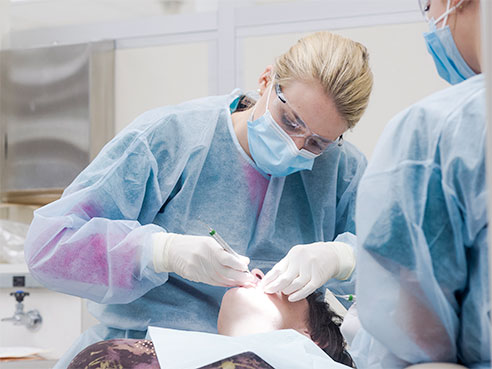 New research from the University of Alabama at Birmingham School of Dentistry shows that women who are pregnant are likely to have moderate to severe gingivitis, and may need regular care to maintain their oral health and help avoid adverse pregnancy outcomes.
New research from the University of Alabama at Birmingham School of Dentistry shows that women who are pregnant are likely to have moderate to severe gingivitis, and may need regular care to maintain their oral health and help avoid adverse pregnancy outcomes.
The study, funded by a grant from Procter & Gamble, also states that gingivitis is relatively stable in the late first and second trimesters. The study was presented by UAB School of Dentistry Dean Michael Reddy, DMD, at the International Association for Dental Research meeting in Seoul, South Korea.
Research shows that fewer than 40 percent to almost 80 percent of pregnant women have gingivitis.
Gingivitis is a common and mild form of gum disease that causes irritation, redness and inflammation. Signs of gingivitis include bad breath and gums that are swollen, soft or tender, or that bleed easily.
Reddy and fellow researchers sought to evaluate the effect, if any, of pregnancy stage, gingivitis-bleeding sites studied, and demographic factors on first- and second-trimester pregnancy gingivitis. Working with trained examiners, they identified more than 600 pregnant women between eight and 24 weeks of pregnancy with at least 30 gingivitis-bleeding sites. The examiners also measured whole-mouth gingivitis scores at up to 168 non-bleeding sites.
The researchers found that maternal age and study site were significant factors in gingival bleeding during the first two trimesters of pregnancy, but that pregnancy stage and ethnicity were not.
Reddy says this study has debunked conventional wisdom about gingival inflammation as pregnancy progresses.
| Gingivitis is a common and mild form of gum disease that causes irritation, redness and inflammation. Signs of gingivitis include bad breath and gums that are swollen, soft or tender, or that bleed easily. |
“Conventional wisdom indicates that gingival inflammation increases progressively throughout pregnancy and returns to baseline levels postpartum,” he said.
Reddy also found that younger women, in general, had higher measured gingival inflammation. This is contrary to science that shows most periodontal diseases tend to escalate in severity associated with age.
“This may represent a lack of exposure to certain microbes in the younger mothers-to-be,” he said.
He cautions all dentists to be aware of the potential issues posed by gingivitis during pregnancy. According to the American Dental Association, untreated dental diseases can be harmful to the mother and the baby.
“Intervention may be important for the patient’s oral health and for the well-being of the fetus,” Reddy said.
Maternal periodontal disease, a chronic infection of the gingiva and supporting tooth structures, has been associated with preterm birth, development of pre-eclampsia, and delivery of an infant small for its gestational age.
Reddy believes further study is needed to clarify which women are at greater risk. He says pregnant women should not be considered as a homogenous group.
“Further study of the demographic, social, environmental, microbial and genetic aspects will enable us to add precision and to use a personalized approach to dentistry during pregnancy,” he said.
The data collected in this study are part of an ongoing randomized clinical trial to evaluate the effect of late-first trimester to mid-second trimester introduction of advanced daily oral hygiene on gingivitis and pregnancy outcomes.
The study included multiple UAB faculty including Professor and Chair of Periodontology Nico Geurs, DDS, Maria Geisinger, DDS, Maninder Kaur, BDS, and Director of the Division of Maternal-Fetal Medicine Joseph Biggio, M.D.
